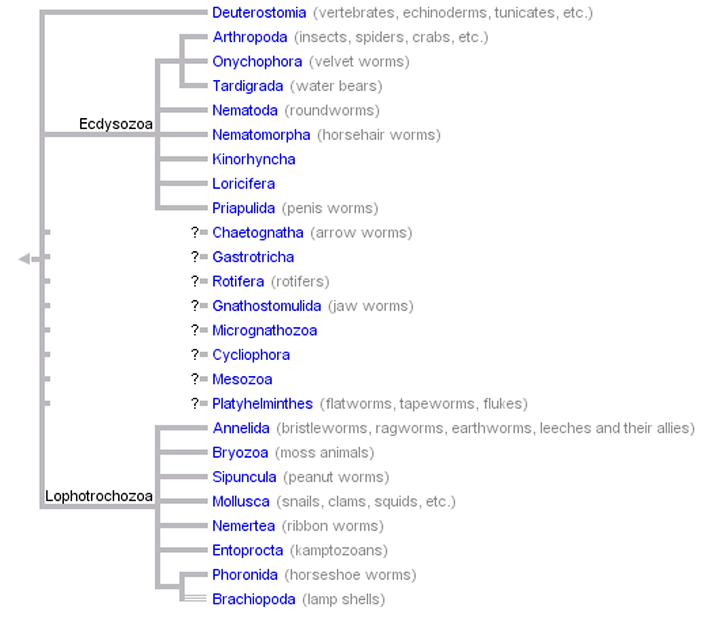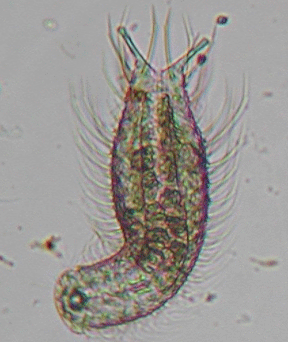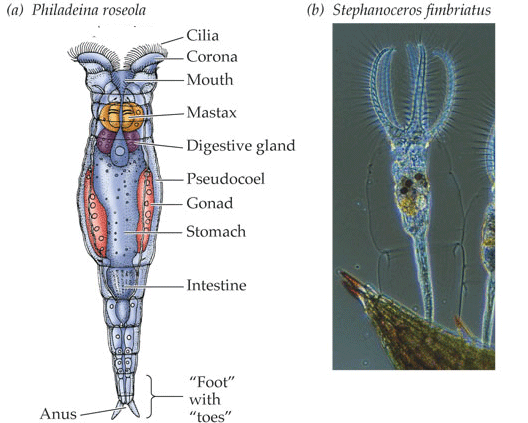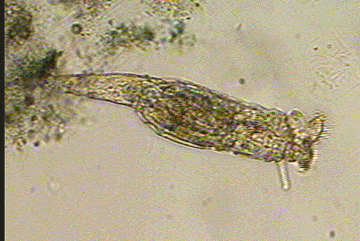
Where do we go from here?
We have explored successful extant clades (phyla) and followed evolutionary groupings.
Metazoa are monophyletic.
So far we have looked at the basal phyla, Porifera, Cnidaria, Platyhelminthes.
We have also explored all of the Deuterostome lineages, most of the Lophotrochozoans and some of the Ecdysozoa.
We have even explored some "problematical" lineages as the lophophorates which once were considered part of the Deuterostome line and now considered part of the Lophotrochozoan line.
We are also going to continue our examination adding clades to the Ecdysozoa.
Finally we will consider more groups no one knows where to place as they are not proper Lophotrochozoans or Ecdysozoans.
New Ecdysozoans:
Relatives of nematodes. (Nematoda) are a very successful and large group based on a simple body design. They are also part of a group know as Cycloneuralia (Nematomorpha, Priapulida, Kinorhyncha, and Loricifera) or groups with a circular brain or nerve ring around anterior digestive tract. Most cycloneuralia also have a pharynx and a hemocoel (pseudocoel) usually filled with cells, but still functions as hydrostatic skeleton to some extent. There usually is a well developed mouth, but a simplified head region. Cycloneuralia are also all Ecdysozoa. They therefore share some characteristics with Arthropods and their relatives. For these reasons they are considered more closely related to Arthropods than any other major clade.
Clades with unknown affinity:
What is also left are the clades with unknown relationships. But there are major groups that share characteristics with these "clades" whose taxonomic status are questionable. We will use Gastrotrichs as an example. Gastrotrichs like many cycloneuralians have a nerve ring around pharynx, a collagenous, non-cellular, external cuticle, and a tri-radiate pharynx. But unlike most cycloneuralians, gastrotrichs do not molt, do have locomotory cilia (covered with a cuticle sheath), and are hermaphroditic.


http://www.gastrotricha.unimore.it/overview.htm
http://www.earthlife.net/inverts/gastrotricha.html
Gastrotrichs were once considered closely related to rotifers.
Rotifers are ciliated, microscopic, mostly microbivores. Rotifers posses a head, trunk and foot regions. They, like gastrotrichs, do not molt.
The name "rotifer" is derived from the Latin word meaning "wheel-bearer"; this makes reference to the crown of cilia around the mouth of the rotifer. The rapid movement of the cilia in some species makes them appear to whirl like a wheel. In most species, the head carries this corona (crown) of cilia that draws a vortex of water into the mouth, which the rotifer sifts for food. But be careful, the corona can be retracted, giving the animal a very different appearance. There are also species that lack a corona. Rotifers may also move by muscular looping or creeping.
Most are transparent and can be recognized by a tiny, calcified, jaw-like structures called trophi. Sexes are separate,but there are species in which males are absent or only produces at certain times of the year.

